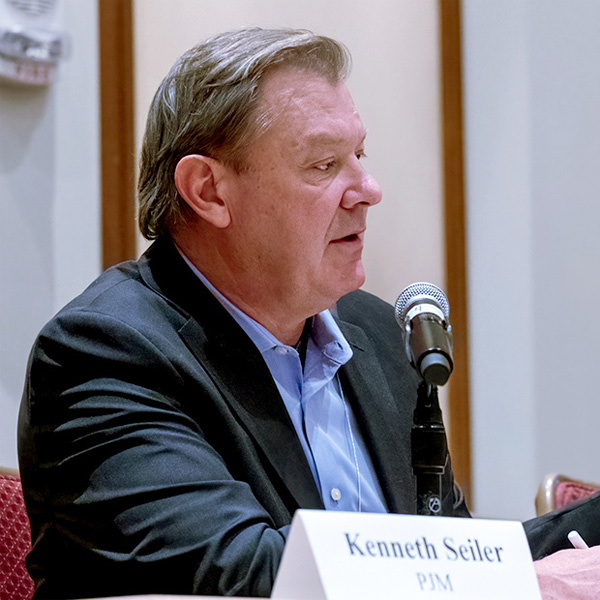VALLEY FORGE, Pa. — Generators that plan to come online by the start of the 2025/26 delivery year will have until Dec. 12 to notify PJM of their intent to participate in the Base Residual Auction (BRA) for that year, slated for June 2024.
PJM’s Pete Langbein told the Market Implementation Committee Nov. 1 that resources that do not notify the RTO by Dec. 12 will not be permitted to participate in the BRA; those that do will be required ultimately to enter an offer.
The requirement is one of several prospective changes to the capacity market that PJM has filed at FERC following the Critical Issue Fast Path (CIFP) process that concluded in October; if the filing is not approved, the notification process will be the same as in past years, with no firm requirements. (See PJM Files Capacity Market Revamp with FERC.)
Langbein said that if a planned resource notifies PJM it will be participating in the auction, any capacity it does not offer cannot be used in that delivery year, including through Incremental Auctions (IAs). He gave the example of a generator that could offer 100 MW into the auction entering in 80 MW. That resource would not be able to offer the remaining 20 MW into subsequent IAs for that delivery year.
An information session will be held Nov. 8 to go over the template that generation owners will be asked to submit to PJM to make the notification. Questions can be submitted to rpm_hotline@pjm.com.
Manual Revisions for New Performance Assessment Interval Triggers Endorsed
The MIC endorsed conforming revisions to Manuals 11 and 18, which sets the capacity market rules, to codify changes to the triggers initiating a performance assessment interval (PAI).
The changes were approved by the Members Committee in May and signed off on by FERC on July 28. (See FERC Approves PJM Change to Emergency Triggers.)
Generators with a capacity commitment are required to meet or exceed their obligation during a PAI or face penalties, which in the case of the December 2022 winter storm amounted to about $1.8 billion.
The changes would set two conditions for triggering a PAI, with the first requiring a primary reserve shortage paired with any one of the following: a voltage reduction warning and reduction of noncritical plant load; manual load dump warning; maximum generation emergency action; or curtailment of nonessential building load.
The second condition requires a deploy-all-resources action, manual load dump action, voltage-reduction action or load-shed directive.
The MC approval of the trigger changes also included modifications to the penalty structure that generators are subject to, but PJM’s Board of Managers included only the trigger changes in the FERC filing. Changes to the penalty structure are included in the CIFP proposal submitted to the commission Oct. 13. (See PJM Board Rejects Lowering Capacity Performance Penalties.)
Stakeholders Endorse Issue Charge on DR Energy Market Parameters
The MIC endorsed an issue charge to explore creating new parameters that demand response resources can enter into the energy market. (See “Voltus Withdraws Issue Charge on DR Offer Parameters” PJM MIC Briefs: Sept 6, 2023.)
Voltus Vice President of Energy Markets Emily Orvis said DR generators lack equivalents to some of the parameters thermal generators can include in their offers, namely maximum run times and minimum times between deployments. Adding those parameters would be particularly beneficial for consumers who can shift building heating and cooling away from peak grid periods, she said. While that energy use could be deferred, temperatures would need to be regulated after some time and a recovery period might be needed before load could be curtailed again.
Resources can offer themselves into the market for specific times of day, but that must be manually done each day and is not flexible. If a resource can be available for only two hours, it would have to choose two hours ahead of time and mark itself as available. Orvis said creating a new parameter would give PJM dispatchers flexibility to call on short-duration DR resources when they would be most economical.
Much of Wednesday’s discussion focused on educating stakeholders on how any changes to energy-only DR resources could affect accrediting corresponding capacity resources under the effective load-carrying capability (ELCC) methodology.
Langbein said economic DR participating in the energy market is treated as a separate resource from load management in the capacity market, and the parameters of one would not affect the other.
Calpine’s David “Scarp” Scarpignato pushed for discussion of any potential interactions with ELCC accreditation to be included as an educational item to check for unintended consequences.
Independent Market Monitor Joe Bowring argued the issue charge should allow for changes to the capacity rules for DR if any interactions are identified during the education process and said market rules should reflect differences between resources.
“The issue is to ensure that any such demand-side resource with limited response times should not be allowed to be a capacity resource because the proposed limits are not consistent with the obligations of demand-side capacity resources,” Bowring said.
Orvis said her priority is to keep the discussion focused on changes to the energy market side, but she acceded to adding education on ELCC interactions to the in-scope portion of the issue charge.
EE Resources Concerned About Issue Charge on Market Participation
PJM presented a first read of a problem statement and issue charge to consider how energy-efficiency resources participate in the capacity market.
Langbein said EE was introduced to the capacity market about a decade ago without any subsequent consideration of how it is functioning, and staff feel it could use a fresh set of eyes.
The work timeline was set at nine months, with the idea that if changes are identified that could be implemented quickly, they could be made in time for the 2025/26 BRA. Langbein said staff aren’t trying to rush any changes and if stakeholders desire more time, the work could continue longer.
Several EE market participants expressed concern about the wide range of the issue charge and urged PJM to include more clarity on the scope. They also sought assurance there would be adequate time for any changes to be understood by all stakeholders and for them to make necessary changes to their offers for the next capacity auction.
Luke Fishback of Affirmed Energy said setting the scope of the issue charge to be so broad makes it difficult for EE market participants to evaluate where the discussion may go and how it may affect their operations, creating a chilling effect. He suggested a phased approach would be preferable to allow any changes that can be made ahead of the auction to be considered while minimizing market disruption before more substantial changes.
“Let’s give adequate time and space for the exercise of evaluating a resource and, in the near term, make sure that market participants can make investments that support their class of resources,” he said.
The problem statement says PJM’s capacity market has seen significant changes since EE was introduced. EE clearing the capacity auction has grown from 78.1 MW in DY 2011/12 to 7,668.7 MW in the 2024/25 BRA, making up about 5% of the capacity procured.
The issue charge would “evaluate EE participation and consider opportunities to eliminate ambiguity regarding what qualifies as an EE resource and ensure the energy saving attributed to the EE resource is nonbiased, accurate and reasonably consistent across providers” and make any changes toward those ends.
Other Committee Business
Stakeholders endorsed an addition to Manual 11, which relates to energy and ancillary services market operations, to define the amount of energy intermittent resources with a capacity commitment are obligated to enter into the day-ahead market. Resources should enter either the larger of their economic maximum value or their expected output based on hourly forecasts. Resources could use PJM’s forecast to estimate their availability or substitute their own forecast so long as it has a higher confidence interval.
The committee also endorsed a quick-fix solution brought by PJM seeking to revise references and typos in Manual 11. The quick-fix process allows an issue charge and solution to be voted on concurrently.


